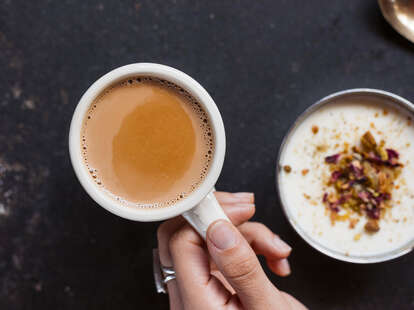
Chai is not native to India. The aromatic, spiced tea has become so synonymous with the country but, like a lot of popular “Indian” dishes such as jalebi and samosa, chai is a result of shared and borrowed culinary heritage—an idea influenced by everything from colonization, trade routes, and migration on the subcontinent.
Today, India is one of the world’s largest producers of tea and, while a certain kind of wild tea plant is said to have existed in the northeast part of the subcontinent, Burma, Thailand, the Himalayan belt, and Tibet, it was the British who were responsible for chai’s domestication in India. After setting up plantations and exporting tea, the British-led associations wanted tea to become popular for the Indians. During this time, the English tea went from plain and dark, to a milky version, doused in ample sugar and spice.

“For Indians, drinking chai is rarely a solitary event,” says chef Meherwan Irani, the founder and executive chef at Chai Pani Restaurant Group, who has two types of chai seasoning under his Spicewalla brand. “It’s an act, something you do with others, a moment enhancer with friends, or a shared experience with strangers. It’s a catchphrase to denote classic Indian hospitality. It’s slang for a quick snack, and also means a small bribe or tip, just enough to cover the cost of a snack and a cup of chai. I could think of no more perfect name than this.”
Irani’s love for chai began in college, when he would leave the house as early as he could, often getting to the campus by 7:30 am, solely for that first cup of chai. “I was never alone, often sipping with the proprietor as he manned the cash drawer, until friends trickled in and we broke their fasts with flaky cream puffs and sweet creamy chai,” he remembers. Later in the afternoon, when his classes were over, he convened again drinking another cup. “Our mind was full of dreams, and cups full of chai.”

Should I use chai tea leaves or powder?
According to Irani, the perfect chai is far from the giant cups of chai latte that we see so often in American coffee shops.
“Those are as far as tofu bacon is from pork belly,” he quips. When tea is made fresh from scratch, it is robust in terms of color and flavor, has a rich body, a sweet taste and a short pour, that’s your desi Indian chai. “It’s the equivalent of a cafe con leche,” he says.
How do you choose the right tea leaves?
Real chai should never be compared to the readily available “tea powder.”
“Tea powder is actually just a by-product of finer, more delicate, loose leaf tea,” Irani explains. “As chai is made from a specific type of tea leaf called CTC (cut, tear, curled) which is dark and has a quick steep time.” He admits that anything else is too weak, or won’t have the classic flavor associated with chai.
Can I enjoy dairy-free chai?
If you don’t consume dairy, try soy, coconut, and any other plant-based milks.
“The higher the fat content in the milk alternative, the more it’ll taste like the real thing,” Irani advises. “But instead of boiling the non-dairy milk along with the tea, make a hot syrup with just water, black tea, and spices, and then, at last, add the warmed up plant-based milk to it.”
What’s the best way to drink chai?
Nothing beats the classic Indian combination of chai and Parle-G. Parle-G is to Indians what Tim Tams are to Australians. “Given that chai is best served sweet, snacks with chai are typically savory, like onion bhaji (fritters), or bun maska (a soft roll with butter),” Irani says. “For me, this combination takes me back to my college years at the canteen.”

How to make perfect masala chai
Ingredients:
• ½ cup water
• ½ cup whole, full-fat milk
• 1 teaspoon CTC tea leaves
• Ginger, cardamom, mint, lemongrass (optional)
• Sugar (optional)
Directions:
1. Bring water and whole full fat milk to a rapid boil and then simmer until the milk is foamy.
2. Add 1 level teaspoon of robust dark roasted tea leaves specially designated for chai (CTC).
3. Add only one or two flavors. This could range from ginger, cardamom, mint, and lemongrass, which are some of the classics or a few pieces of whole spices or a ¼ teaspoon (per cup) of chai masala.
4. Allow this mixture to boil for 2-3 minutes.
5. If you’re adding sugar, sweeten while you’re cooking with regular sugar (no honey).
6. When the tea reaches a medium brown color, strain and serve with sweetener of choice.